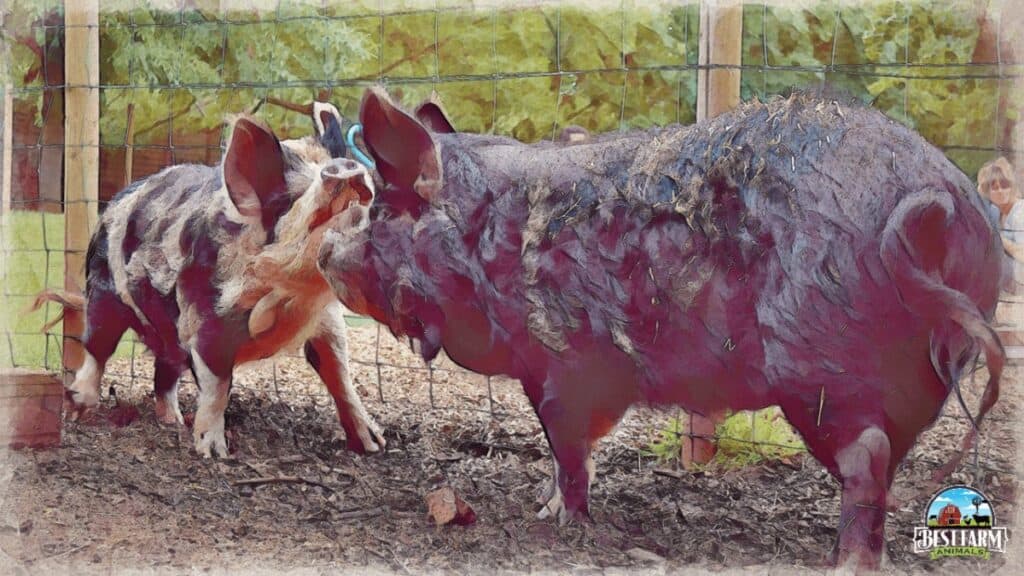Dealing with 650 lb of an angry pig is no joke. It compromises the welfare of other pigs within the herd and endangers anyone involved in handling those animals.
Our first boar was so aggressive that we slaughtered him when he reached market weight. Before that, he bit several people, including myself.
In contrast, our current boar is a pushover. A quick scratch behind the ears, and he rolls over like a dog looking for a belly scratch.
There are reasons why my first pig was aggressive, while other pigs are mellow and easy to be around. When I first started raising pigs, I made many newbie mistakes that aggravated my boar’s aggression.
Fortunately, if you avoid my mistakes, you can raise happier and friendlier pigs.
Are pigs aggressive to humans? Pigs are naturally aggressive, whether to humans or other animals. Pigs use violence to establish dominance within their social group or protect a valuable resource. A pig that’s aggressive towards people is potentially dangerous. Such behavior must be corrected quickly through socialization, training, and improved nutrition and pen design.
In this article, I will cover the most common reasons pigs are aggressive and how to curb aggression to have a happy pig experience.
Are Pigs Aggressive and Dangerous?
Even when they aren’t displaying aggression, pigs can be dangerous because of their large size and heavy weight. Even if a pig isn’t acting aggressively, it can hurt someone in the way. And, pigs are social animals that use aggression to establish a social hierarchy. A dominance-subordinate relationship underpins the social structure of the herd.
Pigs become aggressive and engage in violent fights when mixing with unfamiliar animals. This type of aggression is usually short-lived, lasting between 24 to 48 hours. Once the pigs have established their social hierarchy, the fighting soon subsides. Any lack or scarcity of vital resources like space, water, or feed will aggravate the animal’s natural aggression. Situations like these lead to increased competition and fierce conflicts.
Dominant pigs are more likely to engage in aggressive interactions than submissive pigs. Not only do they engage in more conflicts, but those fights also last longer, increasing the risk of injury.
Age also influences a pig’s level of aggression. A study on the effects of mixing on the aggressive behavior of commercially housed pigs found that animals aged between 25 and 50 days old were more likely to engage in aggressive behaviors than older pigs of 75 days.
Boars or male pigs are more aggressive than sows, although they take longer to engage in a conflict.
In the wild, boars compete with one another over territory and mates. Several factors may exacerbate this natural aggression within a domestic or commercial environment.
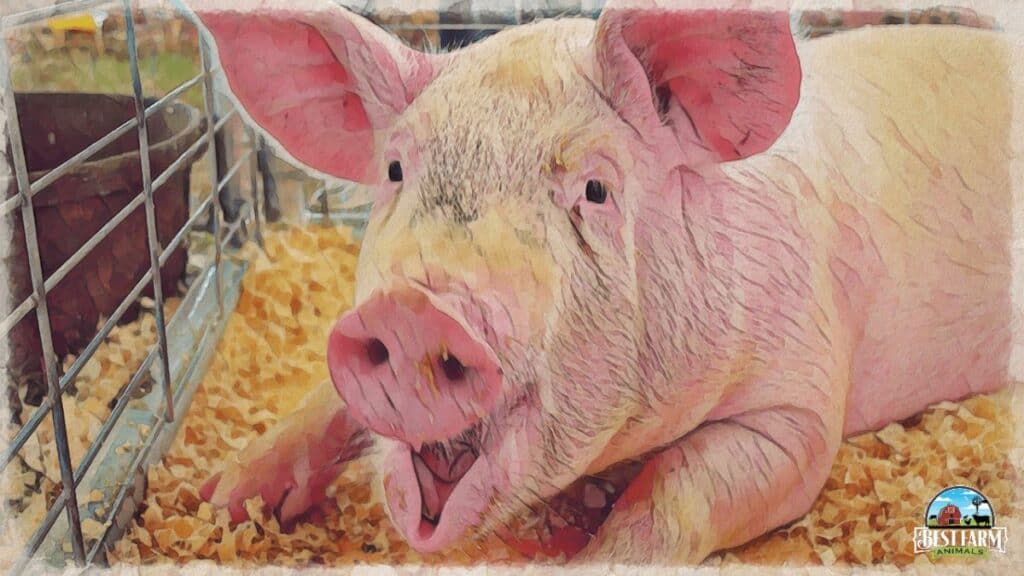
10 Reasons Pigs Become Aggressive
Pigs usually bite people out of fear, aggression, dominance, or boredom. Pigs can accidentally bite when exploring new objects, such as something in a pocket, zippers, or buttons. Additionally, pigs may bite because of feed-related behaviors like hand-feeding or food rationing.
Pigs aren’t usually aggressive, but there are situations that make them more aggressive, leading to dangerous circumstances. Let’s dive into ten reasons pigs become more aggressive.
#1 Mixing Unfamiliar Pigs Causes Aggression
Pigs exhibit aggressive behavior when introduced to unfamiliar animals, including other pigs. They use these conflicts to establish a social hierarchy. Once that dominance-subordinate relationship is in place, the aggressive behaviors will diminish before disappearing.
Other factors are at play if the aggression continues within a stable group. Unfortunately, with my first boar, I changed his pen occasionally, reintroducing him to new pigs. This was poor management on my end. It’s much better to keep pigs in the same social setting.
#2 Genetics Have an Impact on Pig Aggression
Researchers in Sweden and Denmark compared the behaviors of two distinct pig populations. Their findings showed that both aggression and bullying are moderately heritable. Some pigs are genetically predisposed to conflict, while others are naturally submissive. Studies suggest that the genes NR3C1 and AVPR1B are responsible for this aggressive trait.
Aggression is often an individual trait. Among pigs of the same breed, individual traits of aggression can be passed down. If your pigs are showing aggression and none of the other factors are applicable, you may want to bring in pigs with calmer dispositions.
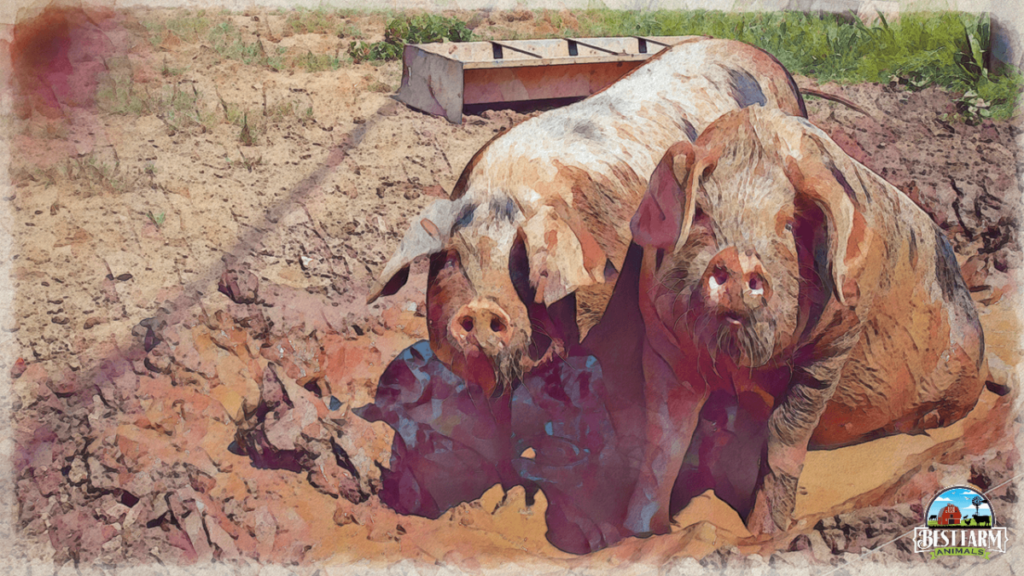
#3 Pigs Fight when Resources are Limited
Food or water scarcity causes pigs to fight over those vital resources aggressively. A pig needs dry, warm areas to rest and access to both water and feed. If any of these are in short supply, conflicts will inevitably occur.
You may be tempted to manage your pigs’ feed so they don’t waste it as much. But, if you are too stringent with food and water- your pigs will fight and become more aggressive when you feed them.
#4 There is a Link Between Poor Air Quality and Aggression
Higher concentrations of ammonia in the air may increase aggression in pigs. Researchers believe this is associated with the pig’s limited ability to regulate its body temperature. As a result, sudden changes in temperature and air quality cause stress which can, in turn, result in more aggressive behaviors.
Ideally, pigs should have different temperature zones within their enclosures. Insulation in the sleeping area ensures thermal comfort, while providing sprinklers or wallows in the foraging area will help keep them cool while active.
#5 Limited Space can Increase Fight Frequency and Severity
Pigs are social animals that benefit from positive social interactions. However, the correct stocking density is critical. Overcrowding can increase both the frequency and severity of negative social interactions.
Limited space availability also makes it difficult for subordinate pigs to escape their aggressors, increasing the likelihood of harmful, violent interactions and the possibility of injury.
Pigs do much better in pens that boarder other pig pens (for socialization) or pens that are big enough for the pigs that are sharing the space. Overcrowding causes so many issues, it isn’t worth it. I’d rather have a couple of fewer pigs that are happy and healthy than overcrowd them.

#6 Poor Nutrition Increases Aggression and Tail-biting
Tail-biting is a common type of aggression seen in commercial pig farms. It occurs when the aggressors chew on the tail of a subordinate animal. Once tail biting begins, it can be tough to stop. The smell of blood also attracts pigs and may cause them to continue biting until the victim requires euthanasia.
Studies show that pigs on a low-protein diet who lack the opportunity to forage are more likely to engage in this destructive behavior. Researchers have also found a link between a low-sodium diet and tail-biting.
Boredom and disease can also increase such aggressive tendencies.
#7 Enriching the Environment can Reduce aggression
Pigs that are kept indoors without the ability to forage need alternative forms of stimulation. Without these, they’re more likely to practice their natural chewing behavior on each other. Providing pigs with “manipulable enrichment materials” such as balls, chains, and rubber hoses can help prevent tail-biting and other forms of aggression.
I know that there are many people who can successfully raise pigs indoors. Some of them write for BestFarmAnimals.com. But, I also know that indoor pigs, especially without the ability to spend time outdoors can become pretty aggressive.
#8 Heavier Animals Fight More Frequently
A pig that weighs 300 lb or more understands that its increased bodyweight gives it an advantage in a conflict. Therefore, heavier animals tend to be more self-confident and aggressive. They are more likely to engage in violent interactions, and because of their weight, those aggressions are likely to be more intense and potentially damaging.
My boar was extremely overweight as we were raising him for the market. Since that point- I’ve done a better job of keeping my boars at a healthier weight which has helped.
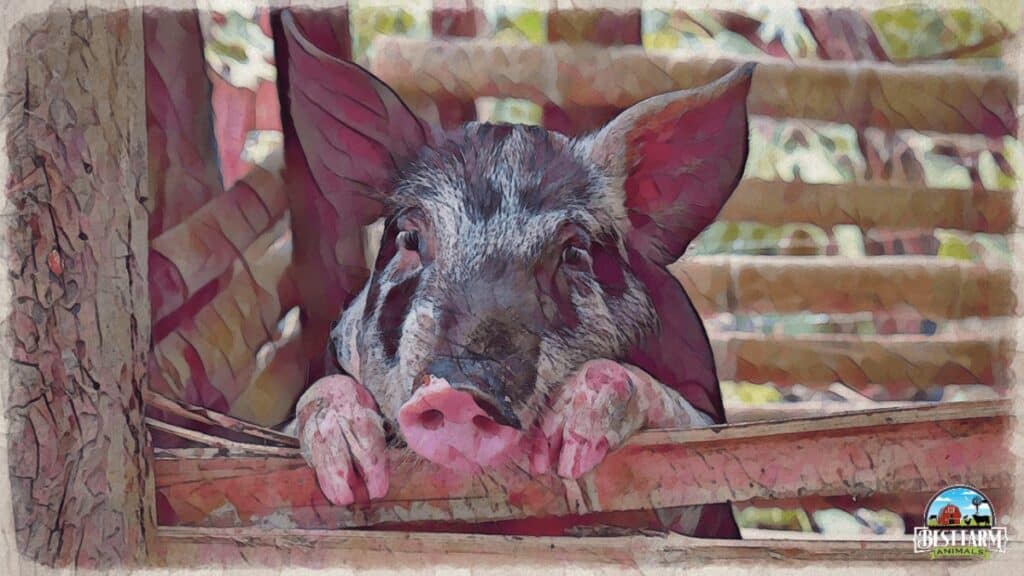
#9 Gender Influences Levels of Aggression
With a natural tendency to fight over mates and territory, male pigs tend to be more aggressive than females. They may also exhibit more aggressive behavior when breeding. The proximity of a sow that’s ready to breed may exacerbate this aggression.
#10 Mishandling can Make a Pig Aggressive
Pig owners that treat their animals as part of the family rather than as farm animals may find their pigs become aggressive. Pigs raised indoors without the opportunity to socialize with other swine may become destructive or belligerent.
Dealing With Pig Aggression That Leads to Pig Bite
While specific individuals may be aggressive initially, the following management techniques can help you reduce the risk of violent conflicts.
Stop pig aggression by socializing piglets to people early. Reduce your pigs’ stress levels by avoiding overcrowding. Provide pens that allow pigs to share critical resources such as food, water, or shade and to explore their surroundings.
Establish your dominance early by responding to your pig firmly, but never aggression or threats. Do not scare your pig, but use a training board to create boundaries when training your pig.
#1 Early Socialization Reduces Violent Conflicts
Exposing piglets to early socialization with people improves their social abilities and reduces the frequency of aggressive encounters in later social events.
You can also curb a pig’s aggressive instincts by minimizing changes to the social structure. Dr. Turner recommends avoiding regrouping pigs whenever possible. This stresses pigs out and changes the social hierarchy. If changes to the social structure are necessary, it’s better to do this as early as possible.
Providing feed ad libitum during reorganization can also reduce the frequency of aggressive conflicts.
#2 An Enriched Environment Reduces Boredom and Aggression
Pigs are natural foragers digging in the earth to uncover roots and other underground delicacies. Providing a substrate for your pigs to forage helps alleviate boredom and encourages natural behaviors.
You can provide additional stimulation by adding enrichment materials to their enclosures. Rubber boots, hoses, balls, and chains can help keep your pigs occupied and reduce the potential for conflict.
#3 Overcrowding can Exacberate Pig Aggression
Enclosed in a small space, pigs will fight over the best spots, especially in very cold, wet, or hot weather. Providing ample space and suitable shelter for your pigs will prevent stress and reduce aggression.
#3 Nutrition and Diet can Reduce Aggression
Studies indicate that low-protein diets can increase the frequency of hostile behavior. Similarly, supplementing your pigs’ diets with tryptophan can reduce aggression in weaners.
Increasing the protein content and frequency of food provision helps reduce unwanted behaviors and aggression.
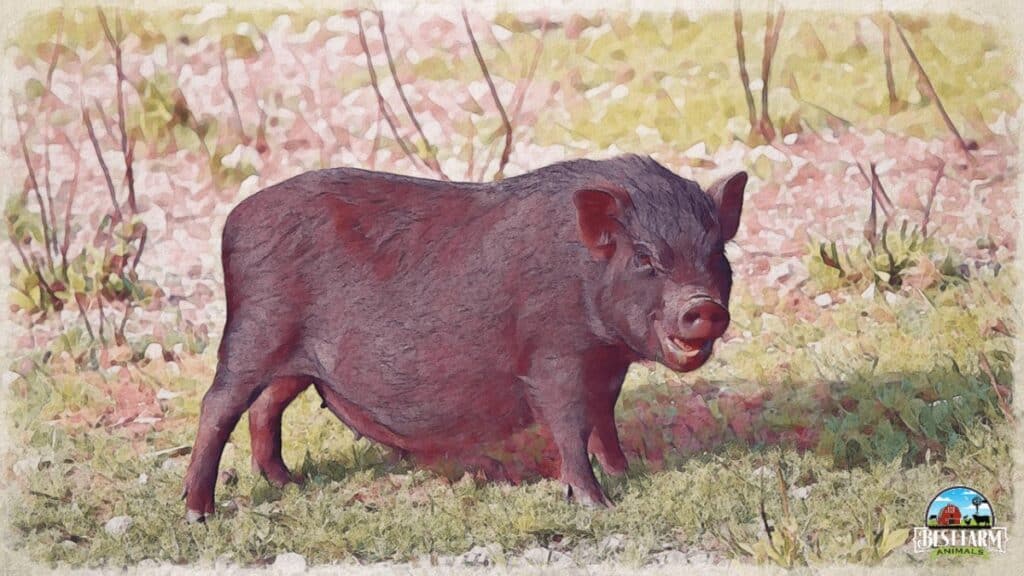
#5 Access to Critical Resources Keeps Pigs Calm
Dominant pigs will attack others to protect critical resources like food, shelter, wallows, and shade. Therefore, if you provide sufficient resources for the herd, acts of aggression should decrease.
That means ensuring pigs have access to enough food. Pigs are also calmer when allowed to choose between various feeds.
Access to shade, water, and wallows is critical, especially in hot weather, when pigs are susceptible to heat stress.
#6 Building Trust will Help your Pig to Relax
Pigs use aggression to protect themselves against potential predators. If your pig perceives you as a threat, it’s more likely to be aggressive. Establishing trust reduces that aggression and creates a safer handling environment.
You can establish trust with your pig by speaking to it softly. Move slowly but purposefully and reward your pigs with treats and tidbits.
If your pig backs away from you, give it more space. Allow your pig to approach you, encouraging it with tasty treats.
Don’t raise your voice or move quickly; this may startle the pig and provoke an aggressive response.
#7 Dominance Helps Create a Safe Handling Environment
Although you don’t want to frighten or intimidate your pig, you do want to establish yourself as a dominant member of its social hierarchy.
Within the herd, dominant pigs use space to establish their superior status. They will step into the personal space of lower-ranking pigs, forcing them to yield and move away.
Replicating this behavior will help you establish a higher rank within the social structure.
Move towards your pig slowly, entering its personal space. Watch his reactions to your proximity. If he moves away, he’s already subordinate to you. However, if he moves into your space, he’s crossed the line and is trying to establish himself as the dominant leader.
Using pressure, you can teach your pig to respect your personal space. If your pig is already showing signs of aggression, you may need a livestock sorting board to protect yourself during training.
If your pig moves toward you, apply more pressure. Move confidently towards him while giving a vocal command to back up. You can reinforce this by clapping or stomping your foot. The moment your pig shows any signs of submission or begins to move away, release the pressure and reward him.
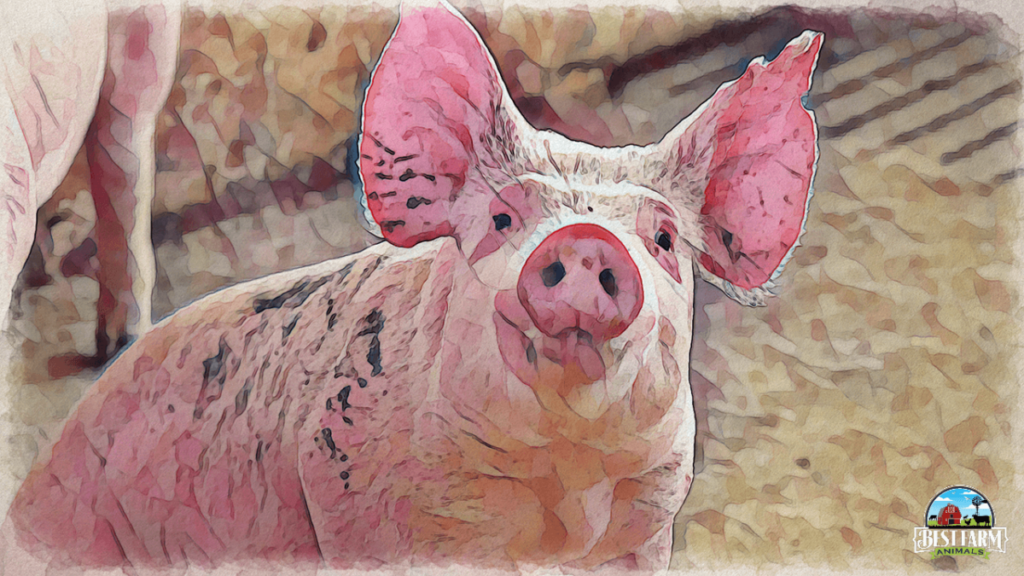
#8 Breeders Should Develop Low Aggression Genetic Lines
Studies show that aggressiveness in sows is a heritable trait. Breeders may select aggressive bloodlines inadvertently in the effort to create highly productive genetic lines.
However, aggression negatively impacts pigs’ welfare and productivity, especially among sows. Therefore, researchers recommend that pig breeders try to “develop low aggression genetic lines.”
This approach to breeding will facilitate group living for these social creatures without damaging productivity or profitability.
The Impact of Aggression on Pig Welfare
Aggression within a herd of pigs can:
- Cause stress
- Negatively impact the growth rate
- Suppress an animals immunity
- Lead to injury, infection, and potential death
Pigs suffering sustained attacks by multiple aggressors will develop sores and lesions. These are usually the result of biting. They may also show signs of lameness and exhaustion.
According to Dr. Simon Turner, a senior researcher in animal behavior at Scotland’s Rural College, any conflicts between pigs are stressful for both the aggressor and the victim. The injuries are also painful and prone to infection.
An animal that’s in pain is more likely to become aggressive toward its handlers and other pigs, but that’s not the only reason pigs bite humans.
An animal that’s in pain is more likely to become aggressive toward its handlers and other pigs, but that’s not the only reason pigs bite humans.
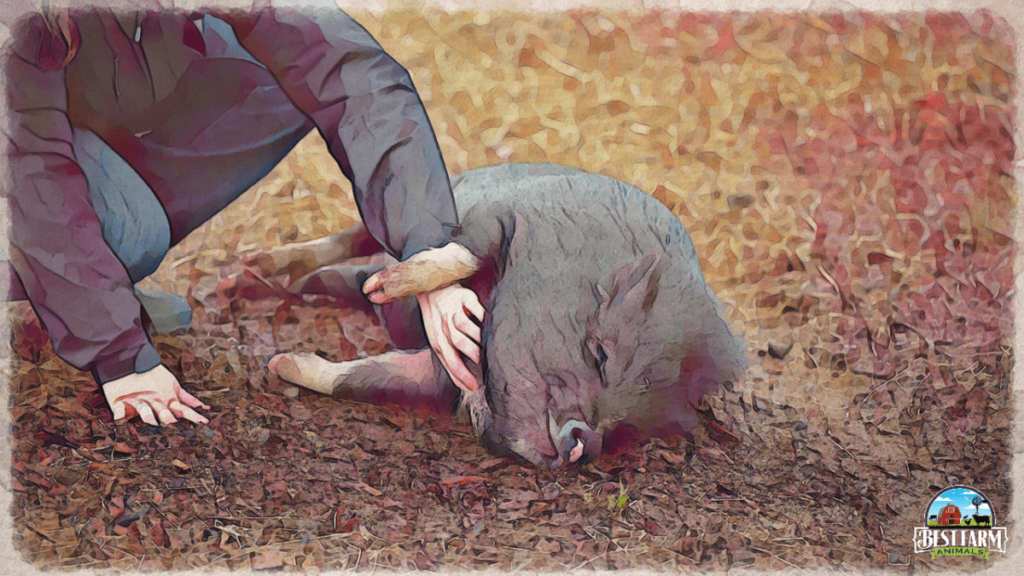
Examples of Aggressiveness in Lactating Sows
A few years ago, one of our Yorkshire sows gave birth to a large litter of piglets. Within their enclosure was a large tree branch which we had placed there to enrich the environment.
Unfortunately, one of the smaller piglets became stuck in the fork between two branches. As it was squealing, I went in to help free its wriggling body. Sadly, the mother perceived my actions as aggressive and responded accordingly.
When I slipped in the mud, the sow was instantly on top of me, her foaming mouth inches from my head. Her sharp hooves dug into my back as she trampled me. Luckily, I managed to wriggle out from underneath her, sustaining nothing more than a few bruises.
This aggression, clearly sparked by her strong maternal instinct, was highly uncharacteristic and quickly forgiven.
I’m not the only one to experience such an ordeal; others have been less fortunate. A case study (references) published in the journal Forensic Science, Medicine and Pathology described a situation in which a 49-year-old man was found dead in his farm’s pigsty.
He had sustained numerous blunt force injuries and “massive upper extremities injuries” that led to such severe bleeding that he lost his life.
What Diseases Do You Get From Pig Bites?
Pigs are probable carriers of two major diseases –Erysipelas & Tetanus; however pigs biting humans transmitting these diseases is rare.
Erysipelas mainly infects pigs or other animals but can infect humans when contracted from pig bites causing redness, swelling and pain at the bite point accompanied by feverish manifestations like chills & body ache.
Tetanus caused by Clostridium tetani bacteria present in soil,& animal feces, mainly living within digestive tracts of certain animals, including pigs leads to muscle stiffness or spasms affecting vital organs producing severe life-threatening complications- another probable disease resulting from pig bites.
Although contracting these illnesses due to a pig bite is unlikely but it inflicts some injury & discomfort requiring immediate wound cleaning with soap& water along with medical aid mainly for those without an updated tetanus vaccination.
A medical professional can evaluate the injury and aid in administering suitable treatment.
Aggressive Pig FAQs
How common are pig attacks?
According to Texas A&M, there have been 412 wild pig attacks on people in 187 years. There aren’t specific records of how often domesticated pigs attack people, and most pig bites are not reported. But, dangerous pig attacks are low such that when pigs are aggressive, it usually makes the news. Pigs are usually considered safe for kids to raise in 4H, although they still have to be respected with their large size.
What’s the most aggressive pig breed? Of all the domestic pig breeds, the most aggressive pig breed is the Hampshire. While Hampshire sows are generally docile and friendly, boars can be difficult to handle. Historically, Durocs have been considered aggressive, but breeders have managed to breed out much of that aggression.
The Duroc is now considered one of the calmest pig breeds, but it is a trait to be aware of when selecting the best pig breed for your home or homestead.
Berkshire pigs are notoriously laid-back and easy going, making them ideal for first-time pig owners. Kunekune pigs and American Yorkshire pigs are also friendly and easy to handle.
Conclusion
Pigs are naturally aggressive, using conflict to establish dominance within their social structures. Too much aggression is bad for their welfare and potentially dangerous for their handlers.
The tips in this article will help you provide the social and physical environments required to reduce aggressiveness and create a safe environment for both your pigs and yourself.
References
National Library of Medicine
Death Cause By Domestic Pig Attack
BioMedCentral
Provision of straw by a foraging tower –effect on tail biting in weaners and fattening pigs
NADIS
Aberrant aggressive behaviour in pigs is widely referred to as vice.
Welfare Quality
Reducing Aggression in Pigs Through Aggressive Breeding
National Library of Medicine
Effects of Mixing on the Aggressive Behavior of Commercially Housed Pigs
My Most Used Pig Supplies
This list contains affiliate products. Affiliate products do not cost more but helps to support BestFarmAnimals and our goal to provide farm animal owners with accurate and helpful information.
Purina Pig Chow will last well (or Mazuri is popular, but I haven’t tried it), and the stainless steel non-skid bowls that will help keep the mess down.
A pig blanket to keep her warm. This one also has bright colors and helps to provide rooting without the destruction.
Pig Harness for walking and handling your pig. There are a lot to choose from, but this one is pretty easy to use. If you want one that has a separate leash, this looks like a good one.
A large crate for keeping her safe in your house at night and when you leave the house. This is essential. You’ll also want a litterbox, and I like mine with a lid for nighttime. Pine shavings are best, and you may be able to find them in larger quantities locally.
When you have accidents, Odoban will help eliminate odors. When you are potty training, these floor pads work great for keeping your house clean while training her to go in certain places.
You’ll also want an outdoor house to keep her warm when she gets outside time, an essential part of her development.
Dewormer- Ivermectin is the primary dewormer I use, although I do rotate with a non-ivermect ingredient once so that the worms don’t get immune to it.

